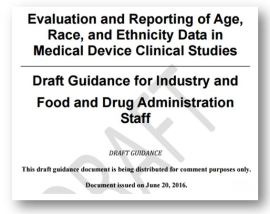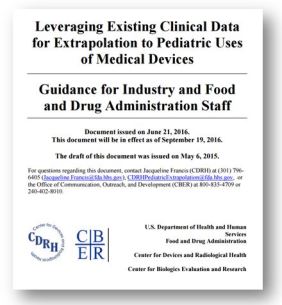FDA BRIEF: Week of June 27, 2016


For devices for which safety, effectiveness or benefit-risk profile expected to vary across subgroups
Applicable to 510(k), PMA, De Novo, HDE applications
Objectives:
- Encourage collection of relevant age, race, ethnicity and associated covariates (e.g., body size, biomarkers, bone density, etc.)
- Recommend analyses and interpretation of data
- Specify expectations for reporting information in summaries and labeling
Terminology & Need:
- Age: Pediatric <22, Older subgroups 65- 261 74, ≥75 years – often underrepresented in clinical trials
- Race and Ethnicity: Categories describing sociocultural construct of US society – distinct lack of publicly reported race and ethnicity data for medical devices
Subgroup Participation : Overcome barriers to enrollment and utilize enrollment resources
Planning at IDE, Premarket and Postmarket Stages: For achieving appropriate enrollment, diverse study recruitment, study design analysis and interpretation, FDA submission

Framework for benefit and risk factors for compliance and enforcement efforts to maximize medical device quality and patient safety
Applies to diagnostic and therapeutic medical devices subject to, and exempt from, Premarket review
Patient Focused Benefit-Risk Assessments:
- Authority to limit availability of violative medical devices with goal of protecting and promoting the public health
- Consider short-term and long-term impact of non-compliance on benefit-risk profile – including patient perspectives
Factors to Consider Regarding Benefit-Risk:
- Benefit: Type, Magnitude, Likelihood, Duration, Patient Preference, Health Care Provider / Caregiver Considerations, Medical Necessity
- Risk: Severity, Likelihood, Duration, Inaccurate Results (diagnostics), Patient Tolerance, Risks for Health Care Provider / Caregiver
- Additional Factors: Uncertainty, Mitigation, Detectability, Failure Mode, Scope of issue, Patient Impact, Preference for Availability, Firm Compliance Issues
FDA Decision-Making considerations:
- Recall strategy : Correction vs. Removal
- FDA actions when continued access to nonconforming device needed during shortage
- Best interest of public health to grant variance from certain requirements identified during PMA pre-approval inspection
- Exercise enforcement discretion and not take immediate action
- Adequacy of manufacturer’s proposed correction strategy
- Issuing Warning Letter or Untitled Letter vs alternative, more informal approach
Worksheets:
- Benefit Assessments
- Risk Assessments
- Assessing potential decisions based on the Benefit-Risk Assessment Outcome

Leveraging relevant available clinical data may increase availability of medical devices for use in pediatric patients
Applicable to PMA, De Novo, HDE applications
Pediatric Medical Device Safety and Improvement Act (PMDSIA), 2007, specifically authorized the use of adult data to demonstrate pediatric effectiveness
“Extrapolation” refers to leveraging process where an indication for use in a new pediatric patient population can be supported by existing clinical data from a studied patient population
Objectives:
- Provide roadmap for leveraging relevant existing clinical data
- Explain appripriate circumstances for leverage existing clinical data
- Outline approach to determine if extrapolation is appropriate
- Describe statistical methodology that can be used to leverage the data in a way that i
Pediatric Age Ranges:
- Neonates: from birth through the first 28 days of life
- Infants: 29 days to less than 2 years
- Children: 2 years to less than 12 years
- Adolescents: aged 12 through 21 (up to but not including the 22nd birthday)
Full and Partial Extrapolation: Use directly or in combination with pediatric data (via statistical model)
Extrapolation for Effectiveness vs. Safety: Extrapolation for safety is expected to be rarer than extrapolation for effectiveness because of physiological differences and lack of power of adult clinical studies to provide comprehensive safety assessments
Pediatric Extrapolation Decision Process and Decision Tree:
- Similarity of existing adult response data/ population characteristics to pediatric
- Quality of adult data – study design, data collection, measurement
- Extrapolated data use to fairly and responsibly assess reasonable assurance of safety and effectiveness

- Allow optional inclusion of graphical representations of information, or symbols, in labeling without adjacent explanatory text- “stand-alone symbols”
- Use of symbols, accompanied by adjacent explanatory text continues to be permitted
- Allow use of “Rx only” or “℞ only” in labeling for prescription devices.

Classifying OTC Electrosurgical Devices for Aesthetic Use as Class II with special controls
------------------------------------------------------------------------
Identified risk Mitigation measure
------------------------------------------------------------------------
Infection.............................. Cleaning Validation.
Labeling.
Adverse Tissue Reaction................ Biocompatibility.
Skin Overheating/Burn.................. Clinical Performance Testing.
Non-clinical Performance
Testing.
Software Verification,
Validation and Hazards
Analysis.
Labeling.
Electromagnetic Interference/Electrical Electromagnetic Compatibility
Shock. Testing.
Electrical Safety Testing.
Labeling.
Worsening Aesthetic Outcomes........... Clinical Performance Testing.
Use Error.............................. Usability Study.
Labeling.
Failure to Identify Correct Population Label Comprehension and Self-
and Condition. Selection Study.
Labeling.
------------------------------------------------------------------------